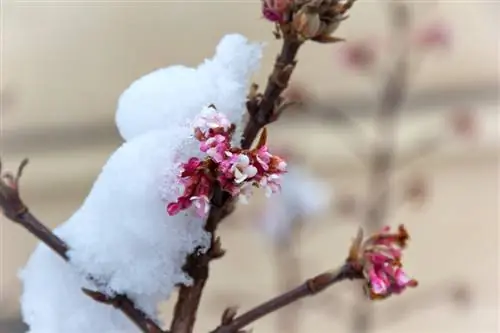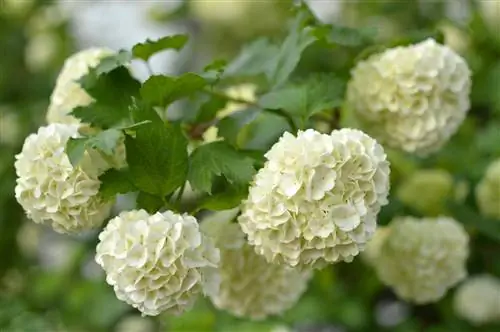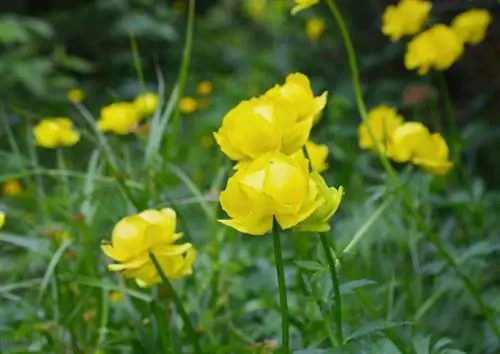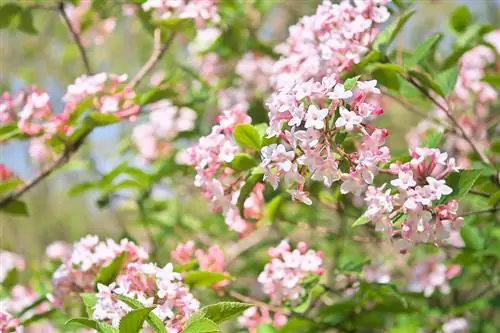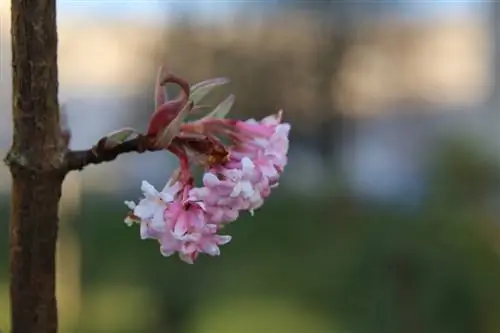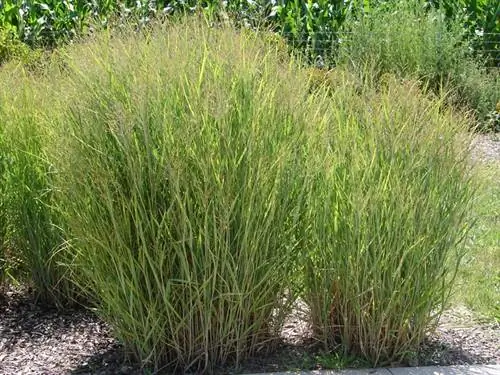- Author admin [email protected].
- Public 2023-12-25 17:45.
- Last modified 2025-06-01 06:02.
Where a pink-white, fragrant flower blossom unfolds in the middle of the cold season, the winter scented snowball is responsible for the floral spectacle. Cultivating this decorative shrub is easier than the atypical flowering period suggests. These answers to frequently asked questions clarify which framework conditions are really important.
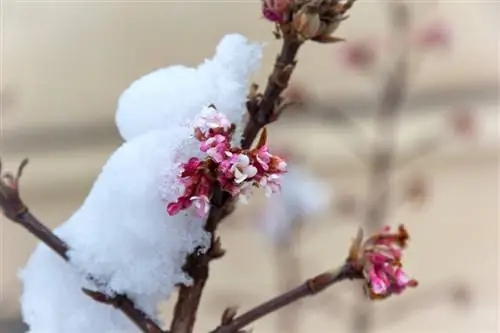
What should you know about the winter scented snowball?
The winter scented viburnum is an ornamental shrub that produces pinkish-white, fragrant flowers from November to March. It prefers sunny to partially shaded locations, fresh, nutrient-rich soil and moderate watering. Care includes regular pruning and organic fertilization in August/September.
Planting winter snowballs correctly
Scented snowballs in containers are planted all year round, provided there are no summer droughts or ground frost. Baled goods are preferably put into the ground in autumn. In a sunny to partially shaded location, prepare the soil with fine crumbs in order to continue following this workflow:
- Dig planting pits at a distance of 30-50 cm with twice the volume of the root ball
- Put the soil in a wheelbarrow to mix in compost, horn shavings and rock dust
- Position the potted plant in the middle of the pit in such a way that the previous planting depth is maintained
After you have filled the cavities with the prepared substrate, water. A mulch layer of leaves, grass clippings or bark mulch keeps the soil moist and warm.
Care tips
Professional care requires little, even from beginners. These are the aspects that really matter:
- Water scented snowball moderately without causing waterlogging
- An organic starter fertilization in August/September with compost, horn shavings and rock dust
- Pruning wilted and too long shoots immediately after the end of the flowering period
Cultivated in a pot, the water and nutrient balance is at a slightly higher level. Always water when the substrate has dried out. Apply a mineral-organic complex fertilizer in solid or liquid form in September, which is refreshed if necessary in December/January.read more
Which location is suitable?
In the sunny location, the winter scented snowball celebrates its most beautiful flower magic. Partially shaded locations are tolerated; However, this comes at the expense of the abundance of flowers. The ornamental tree favors fresh, nutrient-rich soil with first-class drainage. A slightly acidic to neutral pH value of 5.5 to 6.5 is an advantage. Avoid locations with soil that is too moist, as the roots are susceptible to fungal infections.read more
What soil does the plant need?
The flower-filled winter fairy tale is within reach when the scented snowball finds fresh, humus-rich and nutritious soil. The soil should be well-drained with a slightly acidic to neutral pH value of 5.5 to 6.5. A little lime is welcome for the ornamental tree. For cultivation in the bucket, high-quality compost-based soil is suitable, which is enriched with fine grit, lava granules and a little rock dust.
When is flowering time?
Mild winter weather encourages the dark pink buds to open in November. The central flowering period extends from January to March. Enjoy countless, umbrella-shaped flowers in light pink, which are located at the ends of the branches. Depending on the variety, they emit an intoxicating scent of vanilla or cloves. Since there are hardly any pollinators around at this early flowering time, small, dark blue drupes rarely thrive.
Cut winter snowball correctly
The winter scented snowball tolerates pruning well. To keep the magnificent ornamental tree in shape, cut back shoots that are too long immediately after flowering. Place the scissors just above an outward-facing leaf node to encourage further branching. At the same time, thin out the shrub thoroughly so that it does not become bare from the inside. From the fourth year onwards, remove an additional 3-4 of the oldest branches close to the ground. If you maintain this measure every 2-3 years, the scented snowball will remain vital and willing to bloom. Please consider the toxic content in shoots, flowers and leaves when doing any pruning work. Only go to work when you are equipped with robust gloves.read more
Winter snowball watering
An even humidity at a low level; This is how the winter scented snowball likes the environment around its roots. Extreme rashes in dryness or waterlogging cause stunted growth and lazy flowering and even the death of the entire plant. Only water the ornamental tree when the soil has dried thoroughly. The watering can is used less often outdoors than in a bucket on the balcony. A quick finger test provides information about whether there is actually a need for water.
Fertilize winter snowball properly
In nutrient-rich soil, the winter scented viburnum is content with an organic-based nutrient supply. In August/September, work a portion of compost with horn shavings into the surface of the root disc and water again. There is a higher need for fertilizer in the bucket, which you can meet with a complete mineral-organic fertilizer. Apply 4 grams of fertilizer per liter of substrate in September unless the scented viburnum has recently been repotted into fresh soil. In the event that deficiency symptoms occur, fertilize with a reduced dose of 2 grams in December/January.
Propagate winter snowball
Winter scented viburnum can be propagated variably and quickly with top cuttings in summer or cuttings in winter. Place the 10-15 cm long cuttings in pots with lean substrate in a partially shaded, protected and frost-free location. If watered regularly, vital young plants develop and can be planted out in spring or autumn.read more
How do I transplant correctly?
A scented snowball won't hold it against you if it has to change location within the first 5 years. In later years, the significant stress could result in growth depression, at least for a while. Spring - immediately after flowering - is a suitable time for this measure. Please note that the previous planting depth is maintained as far as possible. Furthermore, water abundantly and regularly in the following weeks without causing waterlogging.
Winter snowball in a pot
Cultivation in pots is not ideal; After all, the winter scented snowball will develop its dreamy flair on the balcony and terrace for a few years. As a substrate, we recommend a structurally stable pot plant soil enriched with 20 percent gravel, lava granules or expanded clay. Coarse gravel on the bottom of the pot effectively prevents waterlogging. Keep the soil slightly moist, as constant wetness causes fungal infections and rot. At the start of the growing season, fertilize the scented snowball with 4 grams of complete nutrient fertilizer per liter of substrate and then water generously. Once the winter blossom festival is over, cut back branches that are too long or stunted. From the fourth year onwards, remove an additional 3-4 of the oldest shoots close to the ground in order to repeat this measure every 2-3 years.
Is winter viburnum poisonous?
Unfortunately, the winter scented snowball is not suitable for the family garden. The ornamental tree is poisonous in all parts. Although the level of toxicity is low, a scented snowball should be kept out of the reach of children and pets. We recommend wearing gloves for yourself, as the ingredients can cause unpleasant skin irritation.read more
Beautiful varieties
- Dawn: Opulent scented snowball with white-pink flowers and a captivating vanilla scent in the middle of winter; Growth height 200-250 cm
- Charles Lamont: Impresses with large panicle flowers in dark pink from March to April; Growth height up to 300 cm
- Anne Russel: Robust winter scented snowball that smells seductively of cloves in March and April; Growth height 100-150 cm

